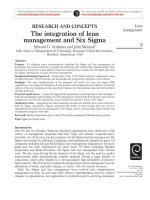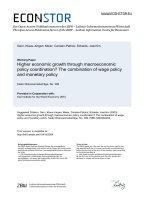The architecture of computer hardware and systems software an information technology approach ch09
Bạn đang xem bản rút gọn của tài liệu. Xem và tải ngay bản đầy đủ của tài liệu tại đây (1.34 MB, 39 trang )
Chapter 9: Input/Output
The Architecture of Computer Hardware
and Systems Software:
An Information Technology Approach
3rd Edition, Irv Englander
John Wiley and Sons 2003
Basic Model
Processing speed or program execution
determined primarily by ability of I/O
operations to stay ahead of processor.
Input
Chapter 9 Input /
Process
Output
9-2
I/O Considerations
Speed Issues
CPU operates at speeds much faster than the fastest I/O device
Devices operate at different speeds
Bursts of data
Block data transfer required for some devices
Coordination
Several devices perform I/O simultaneously
Unexpected input
Various input formats
Status information needed for each device
Chapter 9 Input /
9-3
I/O
Device
Interface
Issues
Different formats
parallel interface
serial interface
Buffering of data
Burst vs. stream
Different control requirements
electromechanical
Chapter 9 Input /
9-4
Examples of I/O Devices
Chapter 9 Input /
9-5
Simple I/O Configuration
Chapter 9 Input /
9-6
I/O Modules Functions
Recognizes messages from device(s) addressed to it
and accepts commands from the CPU
Provides a buffer where the data from memory can be
held until it can be transferred to the disk
Provides the necessary registers and controls to
perform a direct memory transfer
Physically controls the device
Copies data from its buffer to the device/from the
CPU to its buffer
Notifies with interrupts
Chapter 9 Input /
9-7
Input/Output Modules
Programmed I/O
CPU controlled I/O
Interrupt Driven I/O
External input controls
Direct Memory Access Controllers
Method for transferring data between main
memory and a device that bypasses the
CPU
Chapter 9 Input /
9-8
Programmed I/O
I/O data and address registers in CPU
One word transfers
Address information for each I/O device
LMC I/O capability for 100 devices
Full instruction fetch/execute cycle
Primary use:
keyboards
communication with I/O modules (see DMA)
Chapter 9 Input /
9-9
Programmed I/O
Chapter 9 Input /
9-10
Programmed I/O Example
Chapter 9 Input /
9-11
Programmed I/O Example
Chapter 9 Input /
9-12
Interrupts
Signal that causes the CPU to alter its normal flow on
instruction execution
frees CPU from waiting for events
provides control for external input
Examples
unexpected input
abnormal situation
illegal instructions
multitasking, multiprocessing
Chapter 9 Input /
9-13
The CPU - The Interrupt Cycle
Fetch / Execute cycle
Interrupt cycle
START
Fetch Next
Instruction
HALT
Execute
Instruction
Interrupts Disabled
Check/Process
Interrupt
Chapter 9 Input /
9-14
Interrupt Terminology
Interrupt lines (hardware)
Interrupt request
Interrupt handlers
Program that services the interrupt
Also known as an interrupt routine
Process Control Block (PCB)
Located in a part of memory known as the stack
area
All registers of a program are saved here before
control is transferred to the interrupt handler
Chapter 9 Input /
9-15
Interrupt Terminology
Servicing the interrupt
suspends program in progress
saves pertinent information including last
instruction executed and data values in
registers in the PCB (process control block)
branches to interrupt handler
Chapter 9 Input /
9-16
Servicing an Interrupt
Chapter 9 Input /
9-17
Use of Interrupts
Notify that an external event has occurred
real-time or time-sensitive
Signal completion
printer ready or buffer full
Allocate CPU time
time sharing
Indicate abnormal event (CPU originates for
notification and recovery)
illegal operation, hardware error
Software interrupts
Chapter 9 Input /
9-18
Multiple Interrupts
Identifying devices
Polling (checking for input in rotation)
Vectored interrupts (include address of
interrupting device)
Interrupt priorities
Loss of data vs. task completion
Maskable (disabled) interrupts
Chapter 9 Input /
9-19
Vectored Interrupts
Chapter 9 Input /
9-20
Polled Interrupts
Chapter 9 Input /
9-21
Multiple Interrupts Example
Chapter 9 Input /
9-22
Direct Memory Access
Transferring large blocks of data
Direct transfer to and from memory
CPU not actively involved in transfer itself
Required conditions for DMA
The I/O interface and memory must be connected
The I/O module must be capable of reading and
writing to memory
Conflicts between the CPU and the I/O module
must be avoided
Chapter 9 Input /
9-23
DMA Instruction Set
Application program requests I/O service
from operating system
privileged instructions
To initiate DMA, programmed I/O is used to
send the following information:
1.
2.
3.
4.
location of data on I/O device
the starting location in memory
the size of the block
read/write
Interrupt to CPU upon completion
Chapter 9 Input /
9-24
DMA Initiation and Control
Chapter 9 Input /
9-25









